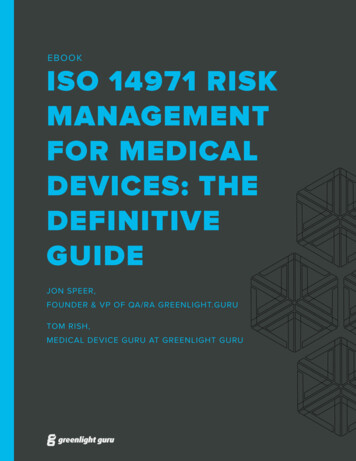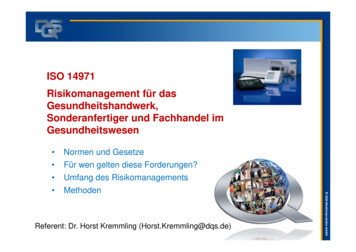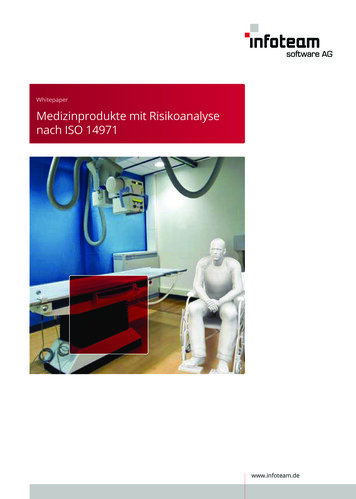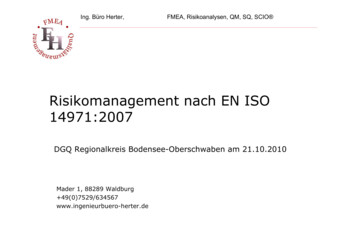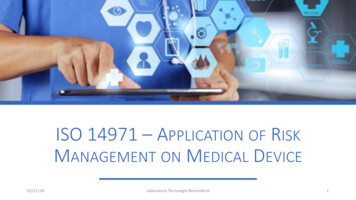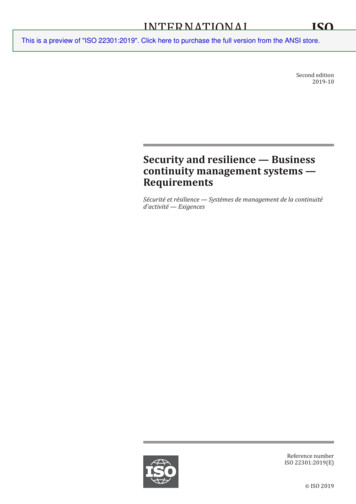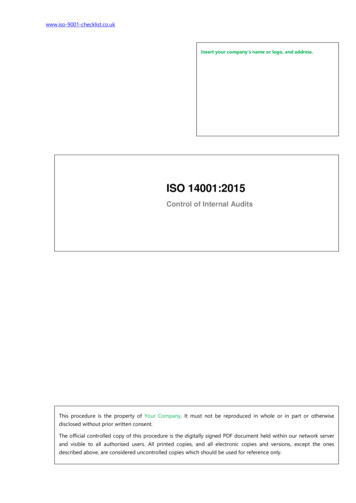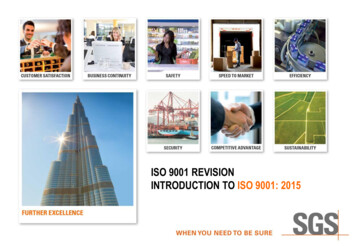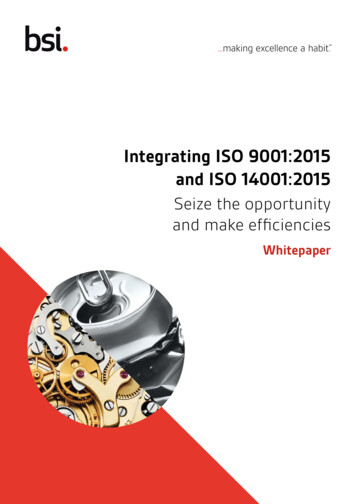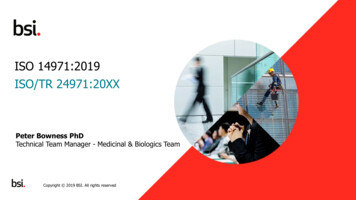
Transcription
ISO 14971:2019ISO/TR 24971:20XXPeter Bowness PhDTechnical Team Manager - Medicinal & Biologics TeamCopyright 2019 BSI. All rights reserved1
ISO 14971:2019 Risk Management for Medical Devices IntroductionTerms & DefinitionsISO 14971:2019 Overview of structure and contentsCurrent status2Copyright 2019 BSI. All rights reserved
IntroductionAs a general concept, an activity in which an individual, organization or government is involved canexpose those or other stakeholders to hazards which can cause loss of or damage to something theyvalue.Risk management is a complex subject as stakeholders place different values on the probability andseverity of harm.medicalpractitionershealth Copyright 2019 BSI. All rights reserved
IntroductionAs one of the stakeholders, the manufacturer makes judgments relating to safety of a medical device,including the acceptability of risks, taking into account the generally aknowledged state of the art, inorder to determine the suitability of a medical device to be placed on the market for its intended use.ISO 14971 specifies a process throughwhich the manufacturer of a medicaldevice can identify hazards associated witha medical device, estimate and evaluatethe risks associated with these hazards,control these risks, and monitor theeffectiveness of that control.For any particular medical device, otherInternational Standards could require theapplication of specific methods formanaging risk.IdentifyEstimate &EvaluateMonitorControl4Copyright 2019 BSI. All rights reserved
IntroductionNot intended for managingproduct related riskISO IEC Directives, HLS (Annex L)ISO31000:2018 & ISO 9000:2015Effect of uncertainty on objectives. Note 1 to entry: An effect is adeviation from the expected. It can be positive, negative or both, and canaddress, create or result in opportunities and threatsFocus on organizational riskISO 14971:2019ISO 13485:2016Organizational risk/business risk is outof the scope of ISO 14971Combination of the probability of occurrence of harm and theseverity of that harmFocus on product safety risk5Copyright 2019 BSI. All rights reserved
IntroductionRisk management as per ISO 14971 is:a systematic approach to identify,assess, control and monitor allrisks associated with the medicaldevice throughout its life cycleInitial conception, design, developmentProduction, distribution, installation, use,service, maintenancePost-production (after market introduction),decommissioning, disposal6Copyright 2019 BSI. All rights reserved
Introduction Fundamental understanding and process for risk management has not changed Multiple stakeholder perspectives exist and need to be considered ISO 14971 is focussed on product safety risks and not organisational or business risks7Copyright 2019 BSI. All rights reserved
Terms & DefinitionsNew in 2019Copyright 2019 BSI. All rights reserved8
Risk Management: Terms & DefinitionsNew Definitionbenefitpositive impact or desirable outcome of the use of a medical device on the health of an individual, or a positive impacton patient management or public healthreasonably foreseeable misuseuse of a product or system in a way not intended by the manufacturer, but which can result from readily predictablehuman behaviourstate of the artdeveloped stage of technical capability at a given time as regards products, processes and services, based on therelevant consolidated findings of science, technology and experienceNote 1 to entry: The state of the art embodies what is currently and generally accepted as good practice in technology andmedicine. The state of the art does not necessarily imply the most technologically advanced solution. The state of the artdescribed here is sometimes referred to as the “generally acknowledged state of the art”.9Copyright 2019 BSI. All rights reserved
Risk Management: Terms & DefinitionsUpdated Definitionaccompanying documentationmaterials document accompanying a medical device and containing information for the operator, the user or thoseaccountable for the installation, use, maintenance, decommissioning and disposal of the medical device, particularlyregarding safe useNote 1 to entry: The accompanying documentation can consist of the instructions for use, technical description, installationmanual, quick reference guide, etc.Note 2 to entry: Accompanying documentation is not necessarily a written or printed document but could involve auditory,visual, or tactile materials and multiple media types.harmphysical injury or damage to the health of people, or damage to property or the environment10Copyright 2019 BSI. All rights reserved
Risk Management: Terms & DefinitionsUpdated Definitionin vitro diagnostic medical deviceIVD medical devicemedical device, whether used alone or in combination, intended by the manufacturer for the in vitro examination of specimensderived from the human body solely or principally to provide information for diagnostic, monitoring or compatibility purposes andincluding EXAMPLE reagents, calibrators, control materials, specimen storage and collection receptacles, software, and relatedinstruments or apparatus or other articlesmanufacturernatural or legal person with responsibility for the design and/or manufacture packaging, or labelling of a medical deviceassembling a system, or adapting a medical device before it is placed on the market or put into service with the intention ofmaking the medical device available for use, under his name, whether or not such a medical device is designed and/ormanufactured by that person himself or on his behalf by another person(s)See also Notes 1-7use erroract or omission user action or lack of user action while using the medical device that leads to a different result than that intendedby the manufacturer or expected by the userSee also Notes 1-511Copyright 2019 BSI. All rights reserved
ISO 14971:2019Overview ofstructure andcontentsCopyright 2019 BSI. All rights reserved12
ISO 14971:2019 Overview of structure and contentsEN ISO 14971:2012 Z Annexes (informative): 13 pages Main body of standard: 9 clauses, 14 pages 10 Annexes (informative): 68 pagesISO 14971:2019 Main body of standard: 10 clauses, 19 pages 3 Annexes (informative): 30 pages13Copyright 2019 BSI. All rights reserved
8. Evaluation of overall residual risk9. Risk management review10. Production and post-production activities1. Information collection2. Information review3. ActionsISO 14971:2019Introduction1. Scope2. Terms and definitions3. General requirements for risk management1. Risk management process2. Management responsibilities3. Qualification of personnel4. Risk management plan5. Risk management file4. Risk analysis1. Risk analysis process2. Intended use and identification of characteristicsrelated to the safety of the medical device3. Identification of hazards4. Estimation of the risk(s) for each hazardous situations5. Risk evaluation6. Risk control1. Risk reduction2. Risk control option analysis3. Implementation of risk control measure(s)4. Residual risk evaluation5. Risk/benefit analysis6. Risks arising from risk control measures7. Completeness of risk control7. Evaluation of overall residual risk acceptability8. Risk management report9. Production and post-production activitiesCopyright 2019 BSI. All rights reservedISO 14971:2007 / EN ISO 14971:2012Introduction1. Scope2. Normative References3. Terms and definitions4. General requirements for risk management1. Risk management process2. Management responsibilities3. Qualification of personnel4. Risk management plan5. Risk management file5. Risk analysis1. Risk analysis process2. Intended use and reasonably foreseeable misuse3. Identification of characteristics related to safety4. Identification of hazards and hazardous situations5. Risk estimation6. Risk evaluation7. Risk control1. Risk control option analysis2. Implementation of risk control measures3. Residual risk evaluation4. Benefit-risk analysis5. Risks arising from risk control measures6. Completeness of risk control14
ISO 14971:2019ISO 14971:2007 / EN ISO 14971:2012Copyright 2019 BSI. All rights reserved15
ISO 14971:2019 Overview of structure and contentsISO 14971:2019ISO 14971:2007 / EN ISO 14971:2012A. Rationale for requirementsA.Rationale for requirementsB. Risk management process for medical devicesB.Overview of the risk management process for medical devicesC. Fundamental risk conceptsC.Questions that can be used to identify medical devicecharacteristics that could impact on safetyD.Risk concepts applied to medical devicesE.Examples of hazards, foreseeable sequences of events andhazardous situationsF.Risk management planG.Information on risk management techniquesH.Guidance on risk management for in vitro diagnostic medicaldevicesI.Guidance on risk analysis process for biological hazardsJ.Information for safety and information about residual riskSeeISO/TR 24971Copyright 2019 BSI. All rights reserved16
ISO 14971:2019 Overview of structure and contents4.4 Risk management plan (3.4)a) the scope of the planned risk management activities, identifying and describing the medical device and the life-cyclephases for which each element of the plan is applicable;b) assignment of responsibilities and authorities;c) requirements for review of risk management activities;d) criteria for risk acceptability, based on the manufacturer’s policy for determining acceptable risk, including criteria foraccepting risks when the probability of occurrence of harm cannot be estimated;e) a method to evaluate the overall residual risk and the criteria for acceptability of the overall residual risk;f) verification activities; andg) activities related to collection and review of relevant production and post-production information.Update to the content of NotesCopyright 2019 BSI. All rights reserved17
ISO 14971:2019 Overview of structure and contents4.5 Risk management file (3.5)Update to Notes only5.1 Risk analysis process (4.1)Update to Notes only5.2 Intended use and reasonably foreseeable misuse & 5.3 Identification of characteristics related to safety (4.2)Separates the requirements into two clausesClause 5.2 clarifies the requirement to document reasonably foreseeable misuse (see new definition also)Requirement generally unchanged5.4 Identification of hazards and hazardous situations (4.3)Adds requirement for hazardous situations to be considered and documentedRefers to Annex CThis is a clarification in the standardCopyright 2019 BSI. All rights reserved18
ISO 14971:2019 Overview of structure and contents5.5 Risk estimation (4.4)Clarification of the textUpdate to NotesRequirement generally unchanged6 Risk evaluation (5)Clarification of the textUpdate to NotesRequirement generally unchanged7.1 Risk control option analysis (6.2)Clause 6.1 has been deletedClarification of the textUpdate to NotesRequirement generally unchangedCopyright 2019 BSI. All rights reserved19
ISO 14971:2019 Overview of structure and contents7.2 Implementation of risk control measures (6.3)Update to NotesRequirement unchanged7.3 Residual risk evaluation (6.4)Deletion of disclosure of residual risk statement and NoteRequirement generally unchanged7.4 Benefit-risk analysis (6.5)Update to NotesRequirement unchanged7.5 Risks arising from risk control measures (6.6)Requirement unchangedCopyright 2019 BSI. All rights reserved20
ISO 14971:2019 Overview of structure and contents7.6 Completeness of risk control (6.7)Requirement unchanged8 Evaluation of overall residual risk (7)Addition of disclosure of residual risk statementClarification of the textUpdate to NotesRequirement generally unchanged9 Risk management review (8)Addition of requirement: The manufacturer shall determine when subsequent reviews of the execution of the risk managementplan need to be performed and when the risk management report needs to be updatedRequirement generally unchangedCopyright 2019 BSI. All rights reserved21
ISO 14971:2019 Overview of structure and contents10 Production and post-production activities (9)Separated into three sub-clauses10.1 Information collectionClarifies the requirement and sources of informationNote on state of the art10.2 Information reviewClarifies the requirement to review for possible relevance to safety and adds third bullet point for changes in general state ofthe art10.3 ActionsSeparates the actions into particular medical device and risk processAdds consideration of devices on the marketClarifies the requirementCopyright 2019 BSI. All rights reserved22
ISO 14971:2019 Overview of structure and contentsAnnex AGenerally updated but remains similar in intent and content, specific to 2019 versionAnnex BProvides a detailed correspondence between ISO 14971:2007 and ISO 14971:2019Updated graphic reflecting the amendments to 2019Annex CDescribes some fundamental risk concepts on hazards, hazardous situations (similar to Annex E)Updated graphic describing the relationship of hazard, sequence of events, hazardous situation and harm (previouslyin Annex E.1). The concept itself is not changedExamples of hazards in Table C.1 updated compared to Table E.1Examples of events and circumstances in Table C.2 updated compared to Table E.2Examples of Relationship between hazards, foreseeable sequences of events, hazardous situations and the harm thatcan occur in Table C.3 updated compared to Table E.3Copyright 2019 BSI. All rights reserved23
ISO 14971:2019 Overview of structure and contentsISO 14971:2019ISO 14971:2007 / EN ISO 14971:201224Copyright 2019 BSI. All rights reserved
ISO 24971:20XXMany of the concepts fromISO14971:2019 are explained infurther detail in ISO/TR 24971:20XXAnnexes from ISO 14971:2007 areincorporated into ISO/TR 24971:20XXCopyright 2019 BSI. All rights reservedISO 14971:2007 / 2012ISO/TR 24971:20XXAnnex AISO 14971:2019Annex BISO 14971:2019Annex CAnnex AAnnex DClaus
ISO 14971 specifies a process through which the manufacturer of a medical device can identify hazards associated with a medical device, estimate and evaluate the risks associated with these hazards, control these risks, and monitor the effectiveness of that control. For any particular medical device, other International Standards could require the application of specific methods for managing .
